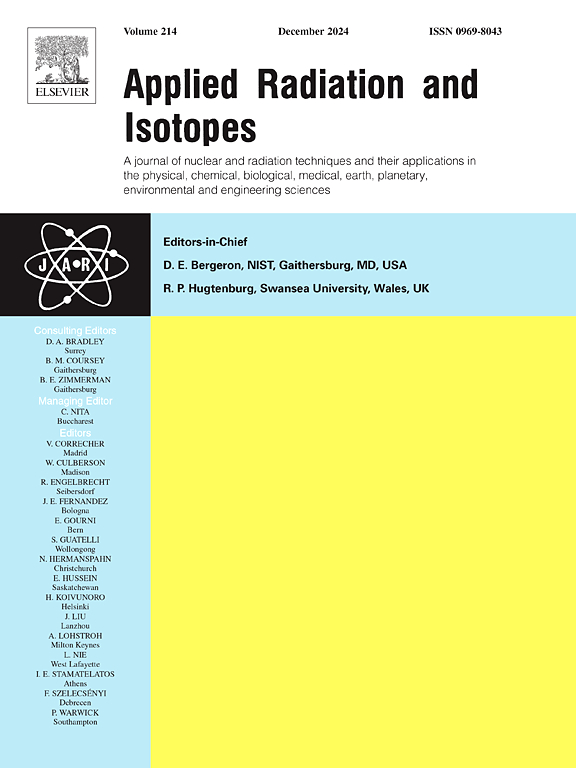Comparison of dose distribution with and without reflecting heterogeneous boron distribution using 18F-BPA positron emission tomography in boron neutron capture therapy
IF 1.6
3区 工程技术
Q3 CHEMISTRY, INORGANIC & NUCLEAR
引用次数: 0
Abstract
This study investigated the dosimetric impact of implementing heterogeneous boron distribution into dose evaluations on tumors in BNCT. The study involved 27 patients who underwent 18F-BPA PET/CT scans. Dose evaluations were performed using various methods reflecting boron concentrations on CT images. The conventional dose evaluations, which reflected uniform boron concentration in blood of 25 ppm and a constant tumor-to-blood (T/B) ratio of 3.5, were compared with individual dose evaluations, which reflected the blood boron concentration and T/B ratio calculated from 18F-BPA in each patient. The heterogeneous tumoral dose distribution was also compared, revealing the dosimetric impact of the boron distribution calculated from each voxel of 18F-BPA. The spatial correspondence between 18F-BPA and dose distribution was compared using metabolic tumor volume (MTV) from 18F-BPA and isodose volume from the heterogeneous dose distribution. Results showed that the median blood boron concentration and T/B ratio calculated from 18F-BPA were 25.57 (23.90–27.84) ppm and 3.75 (2.54–4.59), respectively, comparable to those in the conventional dose evaluations. All dose indices in the heterogeneous tumoral dose evaluations were significantly lower than those in the conventional dose evaluations (p < 0.01). However, the spatial correspondence between the 18F-BPA and the dose distribution was not observed in the dice similarity coefficients of both MTV40-40% isodose volume and MTV50-50% isodose volume. In conclusion, the study confirmed the validity of applying the boron concentration calculated from 18F-BPA to the dose evaluation for a patient in BNCT. The differences might be associated with non-inter-patient variations of 18F-BPA, but the conventional dose evaluations mainly focused on the high boron concentration area within the tumor. Furthermore, the discrepancies in the patients were also observed between the 18F-BPA distribution and the heterogeneous dose distribution. Therefore, this study suggested that the indications for BNCT should consider not only 18F-BPA but also the dose distributions, which could reflect the heterogeneous tumoral boron distribution.
硼中子俘获治疗中,18F-BPA正电子发射断层扫描显示硼非均质分布与不反映硼非均质分布的剂量分布比较
本研究探讨了在BNCT肿瘤剂量评估中采用非均匀硼分布的剂量学影响。这项研究涉及27名接受18F-BPA PET/CT扫描的患者。剂量评估采用不同的方法来反映硼在CT图像上的浓度。常规剂量评估反映血液中均匀的硼浓度为25 ppm,肿瘤与血液(T/B)比值恒定为3.5,与个体剂量评估进行比较,个体剂量评估反映每个患者的血硼浓度和T/B比值由18F-BPA计算。我们还比较了异质肿瘤剂量分布,揭示了18F-BPA每个体素计算的硼分布对剂量学的影响。利用代谢肿瘤体积(MTV)和非均匀剂量分布等剂量体积,比较了18F-BPA与剂量分布的空间对应关系。结果表明,18F-BPA计算的血硼浓度中位数和T/B比值分别为25.57 (23.90 ~ 27.84)ppm和3.75(2.54 ~ 4.59),与常规剂量评估结果相当。异质性肿瘤剂量评估的所有剂量指标均显著低于常规剂量评估(p <;0.01)。而在MTV40-40%等剂量体积和MTV50-50%等剂量体积的骰子相似系数中,18F-BPA与剂量分布没有空间对应关系。综上所述,本研究证实了将18F-BPA计算的硼浓度应用于BNCT患者剂量评估的有效性。这种差异可能与非患者间18F-BPA的差异有关,但传统的剂量评估主要集中在肿瘤内高硼浓度区域。此外,还观察了患者体内18F-BPA分布与非均匀剂量分布之间的差异。因此,本研究提示BNCT的适应症不仅应考虑18F-BPA,还应考虑剂量分布,以反映肿瘤硼分布的异质性。
本文章由计算机程序翻译,如有差异,请以英文原文为准。
求助全文
约1分钟内获得全文
求助全文
来源期刊

Applied Radiation and Isotopes
工程技术-核科学技术
CiteScore
3.00
自引率
12.50%
发文量
406
审稿时长
13.5 months
期刊介绍:
Applied Radiation and Isotopes provides a high quality medium for the publication of substantial, original and scientific and technological papers on the development and peaceful application of nuclear, radiation and radionuclide techniques in chemistry, physics, biochemistry, biology, medicine, security, engineering and in the earth, planetary and environmental sciences, all including dosimetry. Nuclear techniques are defined in the broadest sense and both experimental and theoretical papers are welcome. They include the development and use of α- and β-particles, X-rays and γ-rays, neutrons and other nuclear particles and radiations from all sources, including radionuclides, synchrotron sources, cyclotrons and reactors and from the natural environment.
The journal aims to publish papers with significance to an international audience, containing substantial novelty and scientific impact. The Editors reserve the rights to reject, with or without external review, papers that do not meet these criteria.
Papers dealing with radiation processing, i.e., where radiation is used to bring about a biological, chemical or physical change in a material, should be directed to our sister journal Radiation Physics and Chemistry.
 求助内容:
求助内容: 应助结果提醒方式:
应助结果提醒方式:


